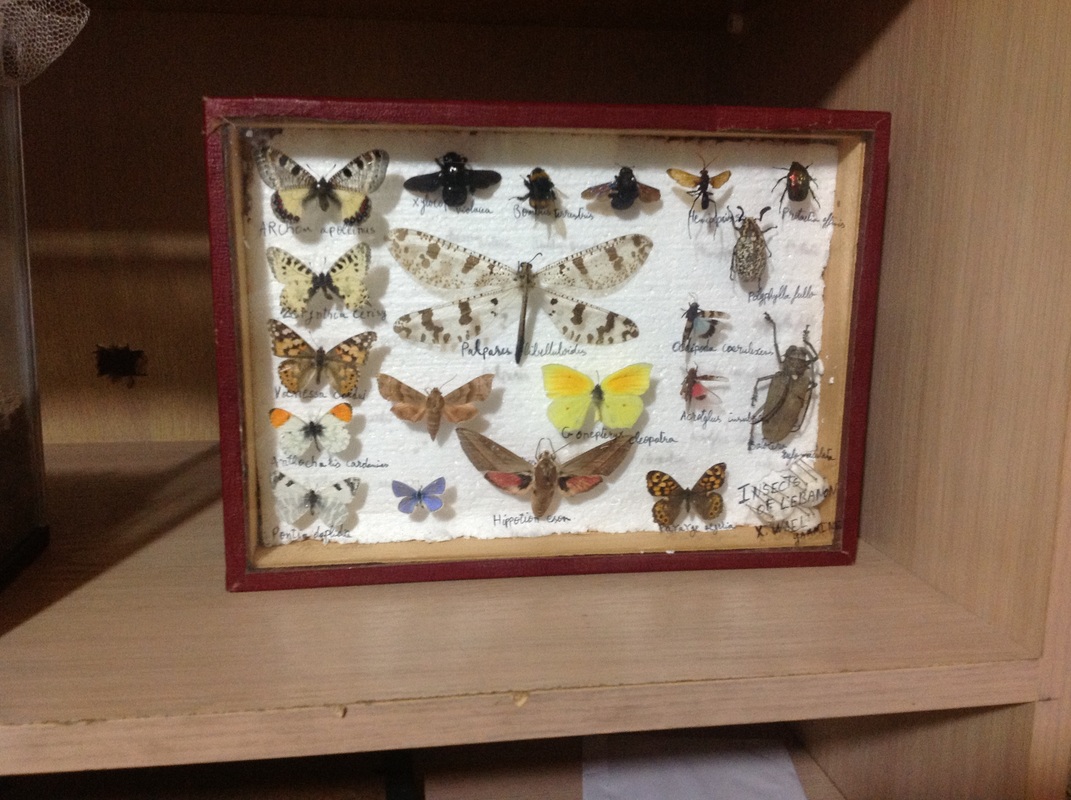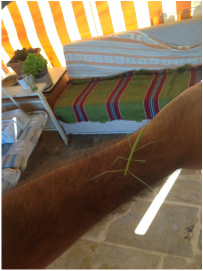Submitted by Wael Yammine
There is an intricate and fascinating world out there just waiting for us to explore it, and it's called "insect land". Insects and mother nature have a lot to teach us. Finding out which insects visit your garden is the first step towards understanding the relationships between them and the different plants, birds and soil so you can better monitor life around the year.
As far as I remember, I was always fascinated by insects. When I was a little boy, I always tried to capture crickets, I tied green scarabs by a string and let them fly in circles. I even used to eat ants to find out how they tasted (yes, my childhood was strange and wonderful).
Today, people still see me running around in the fields chasing after butterflies and other insects - but I do it for different reasons. My dream is to become an entomologist (a scientist who studies insects), so I now take a scientific approach to my hobby.
To observe insects, you need to identify them. For that, you will need to capture a few specimens and examine them calmly. But catching insects isn't as easy as you think. Do you remember how difficult it was as a child to try catching a small grasshopper in the daytime? It will take you even more effort to catch a field cricket at night. Luckily, there are scientific methods and techniques that help you save time and effort.
There are many kinds of traps, but here are 3 simple and affordable ones you can build on your own. These traps are a form of passive collection and should only be used for ecology studies.
Light Trap
This trap is used to capture nocturnal insect that are attracted by light (such as moths and also flying coleoptera - beetles - like the polyphylla fullo), so it only works at night.
There is an intricate and fascinating world out there just waiting for us to explore it, and it's called "insect land". Insects and mother nature have a lot to teach us. Finding out which insects visit your garden is the first step towards understanding the relationships between them and the different plants, birds and soil so you can better monitor life around the year.
As far as I remember, I was always fascinated by insects. When I was a little boy, I always tried to capture crickets, I tied green scarabs by a string and let them fly in circles. I even used to eat ants to find out how they tasted (yes, my childhood was strange and wonderful).
Today, people still see me running around in the fields chasing after butterflies and other insects - but I do it for different reasons. My dream is to become an entomologist (a scientist who studies insects), so I now take a scientific approach to my hobby.
To observe insects, you need to identify them. For that, you will need to capture a few specimens and examine them calmly. But catching insects isn't as easy as you think. Do you remember how difficult it was as a child to try catching a small grasshopper in the daytime? It will take you even more effort to catch a field cricket at night. Luckily, there are scientific methods and techniques that help you save time and effort.
There are many kinds of traps, but here are 3 simple and affordable ones you can build on your own. These traps are a form of passive collection and should only be used for ecology studies.
Light Trap
This trap is used to capture nocturnal insect that are attracted by light (such as moths and also flying coleoptera - beetles - like the polyphylla fullo), so it only works at night.
| You will need: -2 funnels of the same size (opaque) -Black light or small 12 V lamp with battery -A plastic jar with a lid -Epoxy glue -Plexiglas "x" shape (at least 20 cm tall, no wider than the funnels) -Some metal wire Cut a hole in the lid of the plastic jar so the first funnel's narrow base can fit snugly. Use the epoxy glue to fix the Plexiglas "X" standing up in this funnel, then fix the funnel in the jar. Insert the lamp and cable into the second funnel (the funnel’s narrow end should be up). The cable should be connected to a battery and should be long enough to reach the ground (the trap will be hung on a tree or above a door). Now, insert the metal wire through the funnel to hold the lamp in place (it should not be lower than the funnel base, but also not too close to the plastic surface). You can punch 2 holes in the funnel and let the wire pass through them. The wire should be long enough to curve back upwards and form a closed circle. When this is done, stick the second funnel (with the lamp inside it) over the Plexiglas “X” (see the final trap in the picture on the right). Voila! Turn the light on at night and hang your trap. |
Pitfall Bait Trap
This trap is not expensive and is very effective for catching crawling insects that are attracted by smell (such as beetles, ants, etc.).
This trap is not expensive and is very effective for catching crawling insects that are attracted by smell (such as beetles, ants, etc.).
| You will need: -2 long solid plastic cups of the same size -Garden tools to dig a hole -A small cardboard or plastic square -Bait (vinegar, sugar water, beer, etc.) Dig a hole in your garden or the field you want to monitor. Put the cups inside each other and fit them snugly in the hole. Making sure that the edge of the inside cup is at the same level as the soil around it. Place the bait into the cup. Place 4 small stones around the cup and lay the cardboard square above it (maximum 5 cm raised above soil level) with a larger stone to keep it in place. This "roof" will protect captured insects from the sun or predators. Check the trap every 4 days for insects. Note: In rainy weather, it is better to use a plastic square and tilt it so water will flow off it. *Having 2 cups means that when you remove the inside one, the outer one will stay in the ground and preserve the hole shape if you want to use the trap again. |
| Color Trap This trap is for catching insects attracted by color radiation (such as leafminers, ladybugs etc.). You will need: -2 cardboard squares (yellow and white) -Some string -Slow-drying latex or plastic glue (glue) *You can mix the glue with water so it will take more time to dry out Pour glue on the squares then attach them with strings to a tree or pole. They will attract some beneficial insects (ladybugs, Braconidae wasps) and pests (white flies, aphids, tree bugs). |
Identify your crawlers and fliers
Now that you have your first insects, you should try to identify them. In Lebanon this is a little difficult. Unfortunately, there aren't many local experts or resources on insects. Publications about insects are limited to academic researchers in the field and there isn't a book that covers all common insects in the country (unlike books about plants and birds).
Here are some useful books available locally or online:
• Butterflies of Lebanon T. Larsen. Publisher: CNRS Lebanon (ISBN: 0 900848 73 1)
• Dragonflies of the Aammiq Area, Lebanon A Rocha Lebanon*
• Butterflies of the Aammiq Area, Lebanon A Rocha Lebanon*
*See: http://www.arocha.org/lb-en/resources/publications.html)
• The Dragonflies of Europe R. R. Askew. Publisher: Harley Books (ISBN 0 946589 10 0)
The Facebook group Plant production and protection in Lebanon sometimes discusses local insect pests:
https://www.facebook.com/groups/679096865445785/ .
To identify the insects I find, I ask university professors or use these websites:
http://www.biolib.cz/ and http://bugguide.net/node/view/15740.
Now that you have your first insects, you should try to identify them. In Lebanon this is a little difficult. Unfortunately, there aren't many local experts or resources on insects. Publications about insects are limited to academic researchers in the field and there isn't a book that covers all common insects in the country (unlike books about plants and birds).
Here are some useful books available locally or online:
• Butterflies of Lebanon T. Larsen. Publisher: CNRS Lebanon (ISBN: 0 900848 73 1)
• Dragonflies of the Aammiq Area, Lebanon A Rocha Lebanon*
• Butterflies of the Aammiq Area, Lebanon A Rocha Lebanon*
*See: http://www.arocha.org/lb-en/resources/publications.html)
• The Dragonflies of Europe R. R. Askew. Publisher: Harley Books (ISBN 0 946589 10 0)
The Facebook group Plant production and protection in Lebanon sometimes discusses local insect pests:
https://www.facebook.com/groups/679096865445785/ .
To identify the insects I find, I ask university professors or use these websites:
http://www.biolib.cz/ and http://bugguide.net/node/view/15740.
| Insects: What is really at stake? It is vital that we enhance our knowledge of insects. For example, around most of the world, butterflies are known by both their common (vernacular) name and their binomial (Latin) name. But in Lebanon and most of the Arab world probably, butterflies and moths are all called generically "فراشة" farasha. The Vanessa atalanta is a colorful butterfly that is quite common in Lebanon and easily identifiable . In French it is known as "Vulcain", in English "Red admiral", in Spanish "Numerada", in Italian "Vulcano", etc. Can you guess what it is called in Arabic? On the local level, we urgently need to update and publicize documented species of endemic insects in our region. Unfortunately, because war has changed the geopolitical map in the past decades, there is a movement to give some species new names and our region risks losing its identity not only when it comes to entomology, but also with botany, zoology, ornithology, etc. In the bigger picture, insects are the most dominant phylum in the animal kingdom and have a huge biodiversity. One of the most sensitive issues on the agenda of the Food & Agriculture Organization (FAO) is identifying insect species as a new source of protein to fight famine. I am not an expert but I’m passionate about insects and I want more people to take an interest. If you’d like to find out more, email me and I'll be happy to point you in the right direction: [email protected] |







